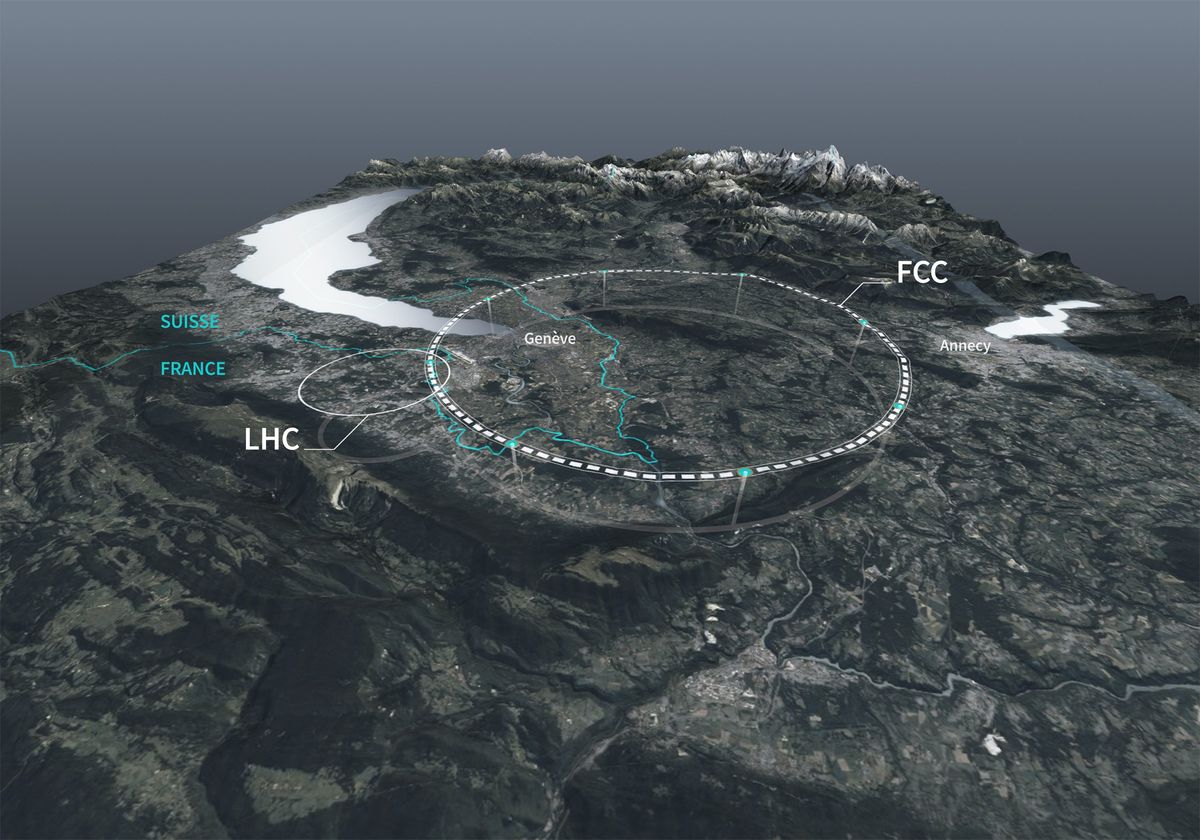Earlier this month, CERN released a preliminary vision of a proposed particle accelerator that, as currently envisioned, would be one of grandest science facilities ever constructed: the behemoth Future Circular Collider (FCC).
The last time CERN took on a project of FCC’s magnitude, the decade was the 1980s, and the object was the Large Electron-Positron Collider (LEP): sometimes described as Europe’s largest civil engineering undertaking up to that time. In the 21st century, engineers retrofitted LEP’s tunnel into today’s Large Hadron Collider (LHC). By smashing atomic nuclei or subatomic particles together at near–light speed, accelerators like LHC have helped dramatically push the boundaries of physics and technology.
“We have to distribute all this power through substations underground.... We are playing with big numbers.” —Jean-Paul Burnet, CERN
Building LHC was certainly a supermassive undertaking, but nothing next to the challenges that building the FCC may bring. “What is changing with FCC is that we have to build new infrastructure in places that are not on CERN land,” says Jean-Paul Burnet, a CERN electrical engineer. But despite FCC’s scale and cost, it is an evolution of existing technology.
The Planning and Burrowing
Detailed conceptual treatments of the gargantuan FCC date back to at least 2014. Over the decade since, engineers and scientists have pored over these proposals, trying to find a suitable alignment for a ring more than three times the LHC’s length. And now, at last, they have their ring: a 91-kilometer near-circle, south of LHC’s existing loop, and bejeweled with eight access shafts that link the tunnel with the surface above. Timothy Watson, a civil engineer at CERN, calls its design “LHC on steroids.”
“It’s very similar in terms of its layout and the engineering input that will be needed to design it and construct it,” he says, “but obviously it’s much bigger.”
Indeed, if you focus on FCC’s design rather than its sheer scale, FCC’s infrastructure might not look too different from those of its antecedents. FCC’s tunnel and access shafts are not significantly wider than LHC’s. The most technically demanding builds will be the collider’s caverns, where the tunnel blows out into larger spaces that hold particle detectors. Even then, Watson says, FCC’s caverns will likely be comparable to those that host LHC experiments like CMS and ATLAS.
That said, there remain a few critical, challenging differences. For one, FCC’s tunnel—averaging 200 meters beneath the surface—will be significantly deeper than LHC’s, and, indeed, several times deeper than most underground metro systems.
Additionally, FCC’s proposed course will take builders through unfamiliar geological conditions. In particular, FCC will need to traverse major bodies of water—namely, Lake Geneva and the River Rhône—challenges of the sort that no prior CERN collider has done.
Still, Watson is confident that existing construction technology—eight tunnel-boring machines, one for each one-eighth of the ring—will be up to the job. “We believe these are things that industry is more than capable of doing,” he says.
Wiring It
To sustain particles at near–light speed, FCC’s tunnel will need all manner of high-tech gadgetry, like chilly cryogenics and high-powered electromagnets. And all that equipment comes at an energy cost. When FCC’s operators first switch it on, it is projected to consume about 1.4 terawatt-hours of electricity for the first-phase FCC lepton collider (FCC-ee), which would accelerate electrons to tiny fractions below the speed of light.
In comparison, the entirety of CERN today—including the LHC itself, the facility’s other colliders, its computers and data centers, its infrastructure—uses 1.3 TWh annually. Then, as scientists anticipate upgrades down the line, including next-generation lepton-hadron and photon-hadron colliders, FCC’s energy demand would only spiral from the baseline 1.4 TWh figure.
Today, CERN draws its electricity from a single 400-kilovolt link with the French grid. Plans call for two more such connections: one 400 kV, the other 225 kV. From these three sources, the collider’s infrastructure would distribute power to the collider’s eight access shafts; from there, it’d be distributed to the rest of the collider.
Unlike prior colliders, which generally sought to minimize the amount of electrical-engineering work underground, FCC’s preliminary designs foresee most of its electricity being distributed within the tunnel systems themselves. “We have to distribute all this power through substations underground,” says Burnet.
No matter how the electrons actually move, they add up to a lot of power: an estimated 350 megawatts. A long-standing goal of CERN’s electrical engineers, Burnet says, is to conserve energy. For instance, one of the largest energy hogs of any particle accelerator is its RF system, necessary for actually accelerating particles. Electrical engineers estimate that by improving the efficiency of its RF system’s klystrons, FCC could save 50 MW.
“We are playing with big numbers,” says Burnet. “We are trying to focus our R&D on this aspect.”
Walking Before Running
After CERN is projected to release more detailed plans next year, CERN’s member countries will determine whether they want to fund the US $17 billion first stage. But even if FCC gets the green light, the construction phase wouldn’t begin for at least the better part of a decade.
So, what happens now are important preliminary steps. For the engineers, the task at hand is to begin probing sites along FCC’s charted course: testing all aspects of the plans and determining if any of it needs altering.
This, again, is just the beginning. “If the project is approved, we will need more site investigation than what we’re planning to do in the next couple of years,” Watson says.
- Powering the Large Hadron Collider ›
- Large Hadron Collider Starts Up ›
- The Engineer Who Pins Down the Particles at the LHC - IEEE Spectrum ›
- Supercolliders: Four Ways Engineers Aim to Break Physics - IEEE Spectrum ›



